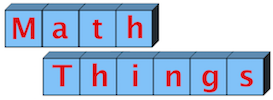Games and Puzzles
Writing Magic Squares
If you like to experiment with Magic Squares, or if you use them in classes, here is an accessible way to create them. This doesn't depend on a single placement strategy or a complex formula, but on patterns that are visible in any magic square.
You can write Magic Squares of different sizes for your students if you wish. Or, you can give that assignment to the students themselves…
Because, using a few steps and a manageable amount of trial and error, students can create their own 3-by-3 and 4-by-4 magic squares. This is appropriate for students in Grades 3 and up who are reasonably fluent in 2-digit addition and subtraction.
Math Crossword Puzzles
Here are some crossword puzzles for students in Grades 3-6. The letter key for all these puzzles is identical. Most of the Math expressions are single-digit multiplication and double-digit addition or subtraction. The words are names of U.S. states, Canadian provinces, countries, and major cities.
These can be downloaded as individual PDFs and printed. There's also a solution document that can be viewed or downloaded.
States on a Coordinate Grid
Here are some coordinate grid puzzles that form U.S. states. The grids include all 4 quadrants, so there are negative coordinates. Some of them are combinations of more than one state.
3-Dimensional Tic-Tac-Toe
There are lots of Tic-Tac-Toe (Noughts and Crosses, whatever) games and strategies out there, but not many truly 3-dimensional games. There are variations which require players to stack a piece on top of a previously played piece, which changes the game. There are games made with a 4-by-4-by-4 array, which eliminates the problem of the first player always winning on the third move, as happens with a 3 by 3 by 3 array. And there are virtual games and formats to play on a single sheet of paper. But there aren’t many ways to play Tic-Tac-Toe in three dimensions the same way it’s played in two.
Here’s a solution. This is a 3 by 3 by 3 array that allows players to play in any space in any order. The one rule change is that the center space is not allowed on the very first move.
The first player will always win even with that rule change, however, as long as the game ends with the first “three in a row.” So it doesn’t. Players continue playing...
Towers of Hanoi
I understand the origins of the Towers of Hanoi is derived from Southeast Asian creation lore. The Creator is playing the game with 64 disks instead of 8. When it's done, the world comes to an end.
A more manageable version includes 8 disks instead of 64. But it's made much more bite-sized by having students try it with 2 disks, then 3, and then with greater numbers.
The rules are as follows...
Pentominoes Checkers
This is a cutthroat game for two players, playing with a set of 12 pentomino pieces.
The pentominoes are all composed of five 1-inch squares arranged so that they are contiguous on at least one full side. There are 12 possible such arrangements of 5 squares.
The game is played on an 8”-by-8” square board...






